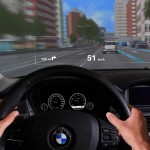 Earlier this year I wrote about a new project, called Rhema, that was developed by researchers at the University of Rochester. It is designed to provide live feedback to you, via Google Glass type devices, as you deliver a speech. It will measure everything from your cadence to your volume and provide feedback via a traffic light style system.
Earlier this year I wrote about a new project, called Rhema, that was developed by researchers at the University of Rochester. It is designed to provide live feedback to you, via Google Glass type devices, as you deliver a speech. It will measure everything from your cadence to your volume and provide feedback via a traffic light style system.
Suffice to say, feedback on the device has been interesting, with some regarding it as valuable, and others finding it all rather distracting.
Distractions on the road
Being distracted whilst giving a public speech is one thing, but it has altogether graver consequences on the road. Numerous studies have highlighted the damage being on mobile phones can cause to our concentration whilst driving, so would augmented reality displays on car windshields be a good or bad thing?
A recent study from the University of Toronto believes that such displays, which typically alert drivers to safety risks but also can include phone activity actually make driving more dangerous.
“Drivers need to divide their attention to deal with this added visual information,” they say. “Not only will drivers have to concentrate on what’s happening on the road around them as they’ve always done, they’ll also have to attend to whatever warning pops up on the windshield in front of them.”
The research saw two experiments conducted to measure the impact augmented windshields had on our attention. Participants were put through a computer based trial to test their ability to identify numbers as quickly as possible. Some of these tests included a secondary distraction, with participants asked to report whether they saw the distraction or not.
The results showed that we are generally pretty alert, but this dropped considerably when the distraction was added. What’s more, a decent number of people failed to even spot the distraction, despite their accuracy falling.
This is likely to be intensified in a driving situation as even more is demanded of us. This often requires us to both identify unusual events and respond to them rapidly and appropriately.
“It would be necessary to distinguish, for example, between warnings of a collision and a recommendation to make a turn,” the authors say. “Otherwise competing warnings may be more dangerous than no warning at all.”
This was highlighted in follow up experiments where participants struggled to identify the appearance of random shapes. The shapes were designed to appear in an unpredictable way, just as an augmented reality display would typically only display something that was happening outside the vehicle.
“Observers made both judgements more slowly when the shape appeared among the spots by as much as 200 percent,” the paper says. “The two visual tasks interfered with each other and impaired both reaction speed and accuracy.”
With most countries now legislating against mobile phone usage whilst driving, it seems a little peculiar that augmented displays could ever really get off the ground given the apparent dangers they pose.
I must say, that would distract the heck out of me. I can't see how it could be possibly safe.
I think this is pretty cool. I mean we cope ok with sat nav don't we? Is this really any different to that?
To be honest, the display in the graphic doesn't look that intrusive. I'm sure the developers have done a lot of testing on this to ensure it doesn't get in the way of visibility.
Interesting, I hadn’t thought of it in that way before.
I think it’s perfectly safe to be honest and can’t wait to be able to use it.